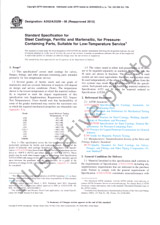We need your consent to use the individual data so that you can see information about your interests, among other things. Click "OK" to give your consent.
ASTM D8171-18
Standard Test Methods for Density Determination of Flax Fiber
Translate name
STANDARD published on 1.1.2018
The information about the standard:
Designation standards: ASTM D8171-18
Note: WITHDRAWN
Publication date standards: 1.1.2018
SKU: NS-809784
The number of pages: 8
Approximate weight : 24 g (0.05 lbs)
Country: American technical standard
Category: Technical standards ASTM
The category - similar standards:
Annotation of standard text ASTM D8171-18 :
Keywords:
archimedes method, buoyancy method, density, fiber density, flax, natural fibers, pycnometer, pycnometry,, ICS Number Code 59.060.10 (Natural fibres)
Additional information
| Significance and Use |
|
5.1 Fiber density is useful in the evaluation of new materials at the research and development level and is one of the material properties normally given in fiber specifications. 5.2 Fiber density can be used to determine fiber strength and modulus of a single fiber or bundle of fibers. These properties are based on load or modulus slope over an effective area. Fiber density, when used with the lineal mass of the specimen, can calculate an approximate, total effective area for the specimen. 5.3 In composite applications, fiber density is used as constituent property when determining reinforcement volume and void volume based on reinforcement mass and laminate density. |
| 1. Scope |
|
1.1 These test methods cover two procedures for determination of the density of flax fiber and are applicable to fibers of any length. 1.1.1 Test Method A—Gas Pycnometry—This is the more accurate method of density measurement and is preferred in cases in which specimen conditioning (oven drying) can be applied or outgassing effects can be mitigated by purge settings. The level of accuracy for the test methods can be assessed from the precision and bias tables. Outgassing effects can be assessed by performing a purge cycle, pressurization, and pressure stability check on the sample. If the pressure increases in an isolated sample chamber, outgassing may affect the accuracy of results. Oven dry specimens below 55 ºC to equilibrium with a 0 % relative humidity (RH) environment or use longer purge methods, or both, to eliminate outgassing effects. 1.1.2 Test Method B—Buoyancy (Archimedes) Method—This is acceptable as an alternative to Test Method A in applications in which less accurate results are sufficient, as represented in the precision and bias tables. Test Method B is preferred in cases in which outgassing effects in Test Method A cannot be addressed by oven drying or purge settings and prevent Test Method A from producing valid results. 1.2 The values stated in SI units are to be regarded as standard. No other units of measurement are included in this standard. 1.3 This standard does not purport to address all of the safety concerns, if any, associated with its use. It is the responsibility of the user of this standard to establish appropriate safety, health, and environmental practices and determine the applicability of regulatory limitations prior to use. 1.4 This international standard was developed in accordance with internationally recognized principles on standardization established in the Decision on Principles for the Development of International Standards, Guides and Recommendations issued by the World Trade Organization Technical Barriers to Trade (TBT) Committee. |
We recommend:
Technical standards updating
Do you want to make sure you use only the valid technical standards?
We can offer you a solution which will provide you a monthly overview concerning the updating of standards which you use.
Would you like to know more? Look at this page.




 Cookies
Cookies
